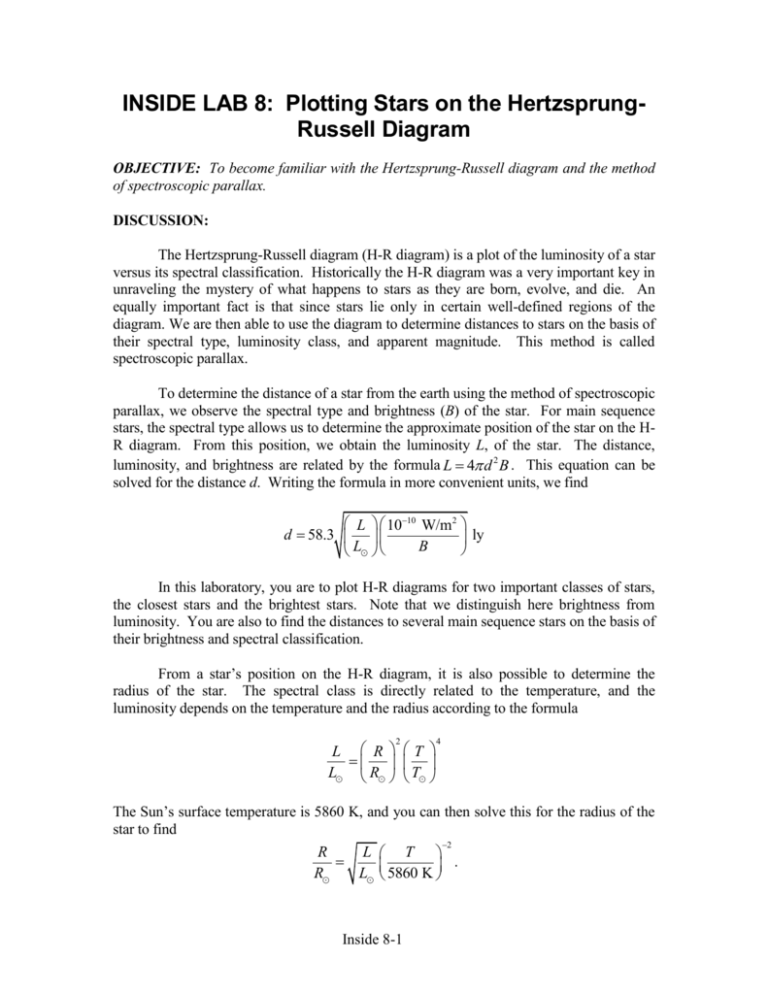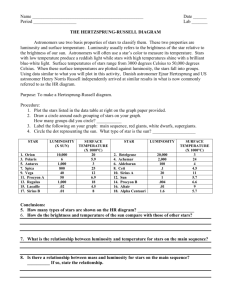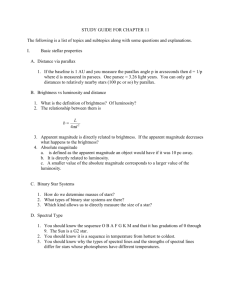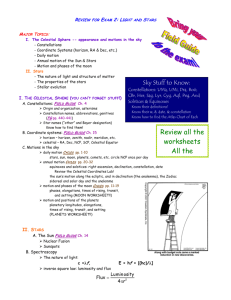INSIDE LAB 6:
advertisement

INSIDE LAB 8: Plotting Stars on the HertzsprungRussell Diagram OBJECTIVE: To become familiar with the Hertzsprung-Russell diagram and the method of spectroscopic parallax. DISCUSSION: The Hertzsprung-Russell diagram (H-R diagram) is a plot of the luminosity of a star versus its spectral classification. Historically the H-R diagram was a very important key in unraveling the mystery of what happens to stars as they are born, evolve, and die. An equally important fact is that since stars lie only in certain well-defined regions of the diagram. We are then able to use the diagram to determine distances to stars on the basis of their spectral type, luminosity class, and apparent magnitude. This method is called spectroscopic parallax. To determine the distance of a star from the earth using the method of spectroscopic parallax, we observe the spectral type and brightness (B) of the star. For main sequence stars, the spectral type allows us to determine the approximate position of the star on the HR diagram. From this position, we obtain the luminosity L, of the star. The distance, luminosity, and brightness are related by the formula L 4 d 2 B . This equation can be solved for the distance d. Writing the formula in more convenient units, we find L 1010 W/m2 d 58.3 ly B L In this laboratory, you are to plot H-R diagrams for two important classes of stars, the closest stars and the brightest stars. Note that we distinguish here brightness from luminosity. You are also to find the distances to several main sequence stars on the basis of their brightness and spectral classification. From a star’s position on the H-R diagram, it is also possible to determine the radius of the star. The spectral class is directly related to the temperature, and the luminosity depends on the temperature and the radius according to the formula 2 L R T L R T 4 The Sun’s surface temperature is 5860 K, and you can then solve this for the radius of the star to find 2 R L T . R L 5860 K Inside 8-1 EXERCISE 1: a) Plot the nearest stars on the provided H-R diagram using one symbol. Do not plot the white dwarf stars. b) On the same graph, plot the brightest stars using another symbol. Temperature (K) 106 30,000 15,400 9,520 8,200 7,200 6,440 6,030 5,770 5,250 4,350 3,850 3,240 105 104 103 Luminosity (L/LSun) 100 10 1 0.1 0.01 10-3 10-4 10-5 10-6 O5 B0 B5 A0 A5 F0 F5 G0 Spectral Type Inside 8-2 G5 K0 K5 M0 M5 EXERCISE 2: Consider the plots you just made and the H-R diagram that was handed out. Since an object appears brighter if it is closer to you than it does if it is far away, one might expect the closest stars to also appear as the brightest stars. Is this the case? Why do some distant stars appear brighter than some nearby stars? Answers: EXERCISE 3: Describe the characteristics of the closest stars: how do they compare with the sun in terms of mass, temperature, radius, luminosity etc. Do the same for the brightest stars. Answers: EXERCISE 4: From these observations, what kinds of stars are most common in the Galaxy? What kinds are rare? From what you know of stellar evolution, why should this be expected? Answers: Inside 8-3 EXERCISE 5: Using the H-R diagram on the next page and the method of spectroscope parallax, find the distances to the following stars in light-years. Note that O stars range in temperature from 60,000 to 30,000 K, B stars from 30,000 to 10,000 K, A stars from 10,000 to 7,500 K, F stars from 7,500 to 6,000 K, G stars from 6,000 to 5,000 K, K stars from 5,000 to 3,500 K, and M stars from 3,500 to 2,000 K. Star Cassiopeia Brightness (10-10 W/m2) 10.6 Spectral Type G0 Luminosity Class V Aquarius 6.51 A0 V Cygnus 7.8 K0 III Inside 8-4 Luminosity (LSun) Distance (ly) Inside 8-5 EXERCISE 6. Consider the H-R diagram in Fig. 12.12 of your textbook or else go to the “Study Area” of the Mastering Astronomy web site, click on Interactive Figures, and click on Fig. 12.08. Using these diagrams, tabulate the physical characteristics of a star with one solar mass at the various stages of its evolution (age, radius, temperature, luminosity). Note that for the white dwarf stage, the temperature changes as it cools off so just choose a convenient temperature that is less than 30,000K. Answers: Stage Radius (RSun) Temperature (K) Main Sequence Red Giant Helium Burning Double shell burning red giant White Dwarf Inside 8-6 Luminosity (LSun)








